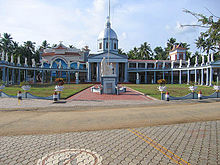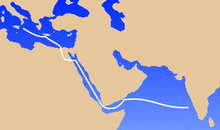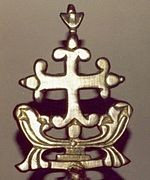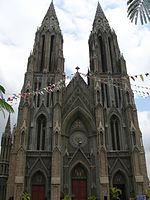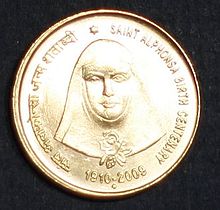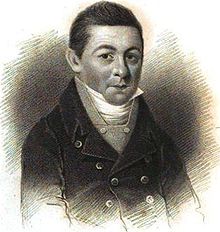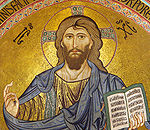- Christianity in India
-
Indian Christians Total population 24,080,016 (2001)[1]
2.3% of the Indian PopulationRegions with significant populations Goa, Kerala, Tamil Nadu, North-Eastern States, Southern India Languages Malayalam, Tamil, Konkani, Telugu, English and various Indian languages
Religion Predominantly Roman Catholic and Protestant. Significant communities of Pentecostal, Baptist and Syrian Orthodox
Related ethnic groups St. Thomas Christians, Goan Catholics, East Indians, Mangalorean Catholics, Khasis, Mizos, Nagas, Anglo-Indians
Christianity is India's third-largest religion, with approximately 24 million followers, constituting 2.3% of India's population.[2] The works of scholars and Eastern Christian writings state that Christianity was introduced to India by Thomas the Apostle, who visited Muziris in Kerala in 52 AD to spread the gospel amongst Kerala's Jewish settlements.[3][4][5] Although the exact origins of Christianity in India remain unclear, it is generally agreed that Christianity in India is almost as old as Christianity itself and spread in India even before it spread to many Christian nations of Europe.[6][7]
Christians are found all across India and in all walks of life, with major populations in parts of South India, the Konkan Coast and the North-East. Indian Christians have contributed significantly to and are well represented in various spheres of national life. They include former and current chief ministers, governors and chief election commissioners.[8][9] Indian Christians have one of the highest literacy, work participation and sex ratio figures among the various religious communities in India.[10][11][12]
Most Christians in India are Roman Catholics (Latin rite). Eastern Churches include the Syro-Malabar Catholic Church the Malankara Orthodox Syrian Church, the Malankara Jacobite Syrian Church and the Malankara Mar Thoma Syrian Church which are prominent in Kerala. Major Protestant denominations include the Church of South India (CSI), the Church of North India (CNI), the Presbyterian Church of India, Baptists, Lutherans and other evangelical groups. The Christian Church runs thousands of educational institutions and hospitals contributing significantly to the development of the nation.[13]
Contents
Early Christianity in India
The Arrival of St. Thomas
Main articles: Syrian Malabar Nasrani and Saint Thomas Christians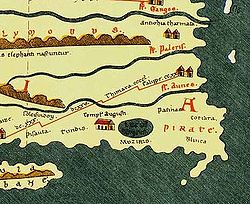 A Peutinger Table's depiction of Muziris near the tip of India where St. Thomas is believed to have landed in 52 A.D.
A Peutinger Table's depiction of Muziris near the tip of India where St. Thomas is believed to have landed in 52 A.D.
According to Indian Christian traditions, the apostle Thomas arrived in Kodungallur (also Muziris), Kerala, established the Seven Churches and evangelized in present day Kerala and Tamil Nadu.[14]
As with early Christianity in the Roman Empire, it is assumed that the initial converts were largely Jewish proselytes among the Cochin Jews who are believed to have arrived in India around 562 BC, after the destruction of the First Temple.[15][16] Many of these Jews presumably spoke Aramaic like St. Thomas, also a Jew by birth, who is credited by tradition with evangelizing India.
A historically more likely claim by Eusebius of Caesarea is that Pantaenus, the head of the Christian exegetical school in Alexandria, Egypt went to India during the reign of the Emperor Commodus and found Christians already living in India using a version of the Gospel of Matthew with "Hebrew letters, a mixture of colture."[17] This is a plausible reference to the earliest Indian churches which are known to have used the Syriac New Testament. Pantaenus' evidence thus indicates that Syriac-speaking Christians had already evangelized parts of India by the late 2nd century.
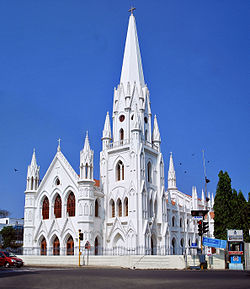 San Thome Basilica in Chennai is built over the site where St.Thomas is believed to be originally interred
San Thome Basilica in Chennai is built over the site where St.Thomas is believed to be originally interred
An early 3rd-century Syriac work known as the Acts of Thomas[18] connects the tradition of the apostle Thomas' Indian ministry with two kings, one in the north and the other in the south. The year of his arrival is widely disputed due to lack of credible records.[3] According to one of the legends in the Acts, Thomas was at first reluctant to accept this mission but the Lord overruled the stubborn disciple by ordering circumstances so compelling that he was forced to accompany an Indian merchant, Abbanes, to his native place in northwest India, where he found himself in the service of the Indo-Parthian king, Gondophares. The apostle's ministry reputedly resulted in many conversions throughout this northern kingdom, including the king and his brother.[18] The Acts of Thomas identifies his second mission in India with a kingdom ruled by King Mahadwa, one of the rulers of a 1st-century dynasty in southern India. According to the tradition of the Mar Thoma or “Church of Thomas,” Thomas evangelized along the Malabar Coast of Kerala State in southwest India, though the various churches he founded were located mainly on the Periyar River and its tributaries and along the coast, where there were Jewish colonies. He reputedly preached to all classes of people and had about seventeen thousand converts, including members of the four principal castes. According to legend, St. Thomas attained martyrdom at St. Thomas Mount in Chennai and is buried on the site of San Thome Cathedral.[19]
 Detail of a stained glass window at the Anglican St. Thomas Cathedral, Mumbai showing Thomas the Apostle in the centre flanked by St. Gabriel and St. Michael on either side. St. Thomas occupies a position of immense significance in Indian Christianity irrespective of denominational differences
Detail of a stained glass window at the Anglican St. Thomas Cathedral, Mumbai showing Thomas the Apostle in the centre flanked by St. Gabriel and St. Michael on either side. St. Thomas occupies a position of immense significance in Indian Christianity irrespective of denominational differences
The world's oldest existing church structure, which was believed to be built by Thomas the Apostle in 57 AD,[20] called Thiruvithamcode Arappally or Thomaiyar Kovil as named by the then Chera king Udayancheral,[21] is located at Thiruvithancode in Kanyakumari District of Tamil Nadu, India. It is now declared an international St. Thomas pilgrim center.
Critical historians treated the Acts of Thomas as an idle tale and denied the historicity of King Gundaphorus until modern archeology established him as an important figure in North India in the latter half of the 1st century.[22] Many coins of his reign have turned up in Afghanistan, the Punjab, and the Indus Valley. Remains of some of his buildings , influenced by Greek architecture, indicate that he was a great builder.[23][24]
Although little is known of the immediate growth of the church, Bar-Daisan (AD 154–223) reports that in his time there were Christian tribes in North India which claimed to have been converted by Thomas and to have books and relics to prove it.[18] Certainly by the time of the establishment of the Sassanid Empire (AD 226), there were bishops of the Church of the East in northwest India, Afghanistan and Baluchistan, with laymen and clergy alike engaging in missionary activity.[18]
Despite lively trade between the Near East and India via Mesopotamia and the Persian Gulf, the most direct route to India in the 1st century was via Alexandria and the Red Sea taking advantage of the Monsoon winds, which could carry ships directly to and from the Malabar coast. The discovery of large hoards of Roman coins of 1st-century Caesars and the remains of Roman trading posts testify to the frequency of that trade. Historian Vincent A. Smith wrote:
“It must be admitted that a personal visit of the Apostle Thomas to South India was easily feasible in the traditional belief that he came by way of Socotra, where an ancient Christian settlement undoubtedly existed. I am now satisfied that the Christian church of South India is extremely ancient... ”.[18]
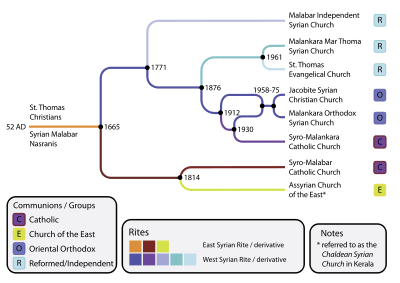 Relationship of the St. Thomas Christian groups
Relationship of the St. Thomas Christian groups
4th century missions
India had a flourishing trade with Central Asia, Mediterranean, and Middle East, both along mountain passes in the north and sea routes along the western and southern coast, well before the start of Christian era, and it is likely that Christian merchants settled in Indian cities along trading routes.[19]
The Chronicle of Seert describes an evangelical mission to India by Bishop David of Basra around the year 300;[25] this metropolitan reportedly made many conversions,[26] and it has been speculated that his mission took in areas of southern India.[27] According to Travancore Manual, Thomas of Cana, a Mesopotamian merchant and missionary, brought a mission to India in 345 AD.[28] He brought 400 Christians from Baghdad, Nineveh, and Jerusalem to Kodungallur. He and his companion Bishop Joseph of Edessa sought refuge under King Cheraman Perumal from persecution of Christians by the Persian king Shapur II. The colony of Syrian Christians established at Kodungallur may be the first Christian community in South India for which there is a continuous written record.[29] A number of historians claim that Thomas of Cana was confused with the 1st century apostle Thomas by India's Syrian Christians sometime after his death and became their Apostle Thomas in India.[30][31][32][33]
Jesus in India theories
The ancient navigation route from the Judeo-Roman world to the Malabar coast Main article: Jesus in India
Main article: Jesus in IndiaThere are also two sets of distinct accounts of Jesus travelling through India.[34] According to the first set of accounts, Jesus traveled and studied in India between the ages of twelve and thirty. According the second set of accounts, Jesus did not die on the cross, but after his apparent death and resurrection he journeyed to Kashmir to teach the gospel, and then remained there for the rest of his life.[34][35] The origin of the first set of accounts is attributed to Russian author Nicolas Notovitch who published the book La vie Inconnue du Jesus Christ (The Unknown life of Jesus Christ) in 1894.[34] Other writers have suggested, however, that Notovitch's claims were a hoax.[36]
The origin of the second set of accounts is attributed to Kashmiri author Mirza Gulam Ahmed who published the book Masih Hindustan Mein (Jesus in India) in 1899.[37] These two accounts are generally not presented in combination. While travel between Middle-East and India was common during those times, these accounts are not given serious thought and treated as speculation since there is no historical account, either in early Christian writings or Indian historical accounts, to either confirm or refute Jesus traveling to India.[34]
Scholars now unanimously consider Notovitch's book as a hoax.[38]
Medieval Period
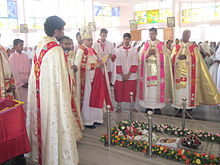 Syro-Malabar Catholic bishop Mar Mathew Arackal (holding the Mar Thoma Cross which symbolizes the heritage and identity of the Syrian Church of Saint Thomas Christians) along with other priests at the tomb of Servant of God Varghese Payapilly Palakkappilly
Syro-Malabar Catholic bishop Mar Mathew Arackal (holding the Mar Thoma Cross which symbolizes the heritage and identity of the Syrian Church of Saint Thomas Christians) along with other priests at the tomb of Servant of God Varghese Payapilly Palakkappilly
The Syrian Malabar Nasrani community was further strengthened by various Persian immigrant settlers, the Christian-Jewish Knanaya colonies of 3rd century, Manichaeanism followers, Babylonian Christians settlers of 4th century AD, the Syrian settlements of Mar Sabor Easo and Proth in 7th century AD and the immigrant Persian Christians from successive centuries.
Local rulers in Kerala gave the St. Thomas Christians various rights and privileges which were written on copper plates. These are known as Cheppeds, Royal Grants, Sasanam etc.[39] There are a number of such documents in the possession of the Syrian churches of Kerala which include the Thazhekad Sasanam, the Quilon Plates (or the Tharisappalli Cheppeds), Mampally Sasanam and Iraviikothan Chepped etc. Some of these plates are said to be dated around 774 AD. Scholars have studied the inscriptions and produced varying translations. The language used is Tamil in Tamil letters intermingled with some Grantha script and Pahlavi, Kufic and Hebrew signatures.
The ruler of Venad (Travancore) granted the Syrian Christians seventy two rights and privileges which were usually granted only to high dignitaries. These rights included exemption from import duties, sales tax and the slave tax. A copper plate grant dated AD 1225 further enhanced the rights and privileges of Nasranis.
The South Indian epic of Manimekalai (written between 2nd and 3rd century AD) mentions the Nasrani people by referring to them by the name Essanis. The embassy of King Alfred in 883 AD sent presents to St. Thomas Christians.[40] Marco Polo who visited in 1292, mentioned that there were Christians in the Malabar coast.[41] The Saint Thomas Christians still use the Syriac language (a dialect of Aramaic, which is also the language that Jesus spoke[42]) in their liturgy. This group, which existed in Kerala relatively peacefully for more than a millennium, faced considerable persecution from Portuguese evangelists in the 16th century.[43][44] This later wave of evangelism spread Catholicism more widely along the Konkan coast.[45][46]
Modern period
The arrival of Catholicism
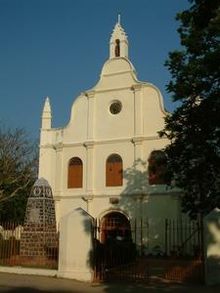 St. Francis CSI Church, in Kochi, built in 1503, is the oldest European church in India
St. Francis CSI Church, in Kochi, built in 1503, is the oldest European church in India
The French Dominican missionary Jordanus Catalani was the first European to start conversion in India. He arrived in Surat in 1320. After his ministry in Gujarat he reached Quilon in 1323. He not only revived Christianity but also brought thousands to the Christian fold. He brought a message of good will from the Pope to the local rulers. As the first bishop in India , he was also entrusted with the spiritual nourishment of the Christian community in Calicut , Mangalore, Thane and Broach (north of Thane).[47]
Portuguese missionaries reached the Malabar Coast in the late 15th century, made contact with the St Thomas Christians in Kerala (who were following Eastern Christian practices at that time) and sought to introduce the Catholicism among them. In the 16th century, the proselytization of Asia was linked to the Portuguese colonial policy. With the Papal bull – Romanus Pontifex[48] written on 8 January 1455 by Pope Nicholas V to King Afonso V of Portugal, the patronage for the propagation of the Christian faith (see "Padroado") in Asia was given to the Portuguese, who were rewarded with the right of conquest.[49]The missionaries of the different orders (Franciscans, Dominicans, Jesuits, Augustinians, etc.) flocked out with the conquerors, and began at once to build churches along the coast districts wherever the Portuguese power made itself felt.
The history of Portuguese missionaries in India starts with the neo-apostles who reached Kappad near Kozhikode on 20 May 1498 along with Vasco da Gama,[50] which represents less than 2% of the total population[51] and is the largest Christian church within India.[50] who was seeking to form anti-Islamic alliances with pre-existing Christian nations. The lucrative spice trade was further temptation for the Portuguese crown.[52]
During the second expedition, the Portuguese fleet comprising 13 ships and 18 priests, under Captain Pedro Álvares Cabral, anchored at Cochin on 26 Nov. 1500. Cabral soon won the goodwill of the Raja of Cochin. He allowed four priests to do apostolic work among the early Christian communities scattered in and around Cochin. Thus Portuguese missionaries established Portuguese Mission in 1500. Dom Francisco de Almeida, the first Portuguese Viceroy got permission from the Kochi Raja to build two church edifices – namely Santa Cruz Basilica (Founded : 1505) and St. Francis Church (Founded : 1506) using stones and mortar which was unheard of at that time as the local prejudices were against such a structure for any purpose other than a royal palace or a temple.
In the beginning of the 16th century, the whole of the east was under the jurisdiction of the Archdiocese of Lisbon. On 12 June 1514, Cochin and Goa became two prominent mission stations under the newly created Diocese of Funchal in Madeira. In 1534, Pope Paul III by the Bull Quequem Reputamus, raised Funchal as an archdiocese and Goa as its suffragan, deputing the whole of India under the diocese of Goa. This created an episcopal see – suffragan to Funchal, with a jurisdiction extending potentially over all past and future conquests from the Cape of Good Hope to China.
After four decades of prosperous trading, the missionaries started the proselytization around 1540 and during this period, foreign missionaries also made many new converts to Christianity. Early Roman Catholic missionaries, particularly the Portuguese, led by the Jesuit St Francis Xavier (1506–52), expanded from their bases on the west coast making many converts. The Portuguese colonial government supported the mission and the baptized Christians were given incentives like rice donations, good positions in their colonies. Hence, these Christians were dubbed Rice Christians who even practiced their old religion. At the same time many New Christians from Portugal migrated to India as a result of the inquisition in Portugal. Many of them were suspected of being Crypto-Jews, converted Jews who were secretly practicing their old religion. Both were considered a threat to the solidarity of Christian belief.[53] Saint Francis Xavier, in a 1545 letter to John III of Portugal, requested the Goan Inquisition[53][54], which is considered a blot on the history of Roman Catholic Christianity in India, both by Christians and non-Christians alike.
In 1557, Goa was made an independent archbishopric, and its first suffragan sees were erected at Cochin and Malacca. The whole of the East came under the jurisdiction of Goa and its boundaries extended to almost half of the world: from the Cape of Good Hope in South Africa, to Burma, China and Japan in East Asia. In 1576 the suffragan See of Macao (China) was added; and in 1588, that of Funai in Japan.
The death of the last metropolitan bishop – Archdeacon Abraham of the Saint Thomas Christians, an ancient body formerly part of the Church of the East[55][56] in 1597; gave the then Archbishop of Goa Menezes an opportunity to bring the native church under the authority of the Roman Catholic Church. He was able to secure the submission of Archdeacon George, the highest remaining representative of the native church hierarchy. Menezes convened the Synod of Diamper between 20 and 26 June 1599,[57] which introduced a number of reforms to the church and brought it fully into the Latin Rite of the Catholic Church. Following the Synod, Menezes consecrated Francis Ros, S. J. as Archbishop of the Archdiocese of Angamalé for the Saint Thomas Christians – another suffragan see to Archdiocese of Goa and Latinisation of St Thomas Christians started and most, eventually accepted the Catholic faith, but a part of them switched to West Syrian rite. The Saint Thomas Christians were pressured to acknowledge the authority of the Pope[57]. Resentment of these measures led to some part of the community to join the Archdeacon, Thomas, in swearing never to submit to the Portuguese or to accept the Communion with Rome in the Coonan Cross Oath in 1653.
The Diocese of Angamaly was transferred to Diocese of Craganore in 1605; while, in 1606 a sixth suffragan see to Goa was established at San Thome, Mylapore, near the modern Madras. The suffragan sees added later to Goa. were the prelacy of Mozambique (1612) and in 1690 two other sees at Peking and Nanking in China.
Mangalore is another significant region on the west coast which has a huge Christian population. In 1321, the French Dominican friar Jordanus Catalani of Severac (in south-western France), who also worked in Quilon arrived in Bhatkal, a place near Mangalore and established a missionary station there. Many locals were converted to Christianity by Jordanus. .[47] The Portuguese were however unable to establish their presence in Mangalore as a result of the conquests of the Vijayanagara ruler Krishnadevaraya and Abbakka Rani of Ullal, the Bednore Queen of Mangalore. Most of Mangalorean Catholics were not originally from Mangalore but are descendants of Goan Catholics who fled Goa during the Portuguese-Maratha Wars and the Goan Inquisition.
The origin of Christianity in North Konkan, was due to the proselytizing activities of the Portuguese in the 16th century. The French Dominican friar Jordanus Catalani of Severac (in south-western France) started evangelizing activities in Thana.[58] On the occasion of The Golden Jubilee of Queen Victoria, the Christians of North Konkan, in Maharashtra who were known as Portuguese Christians discarded that name and adopted the designation East Indians.[59] Marathi Christians are Protestants and are therefore distinct from East Indian Christians who are predominately Roman Catholics and inhabitants of the North Konkan region. Marathi Christians can be found in the areas of Ahmednagar, Solapur, Pune & Aurangabad. They were converted through the efforts of the American Marathi Mission, The SPG Mission, and the Church Mission Society of Church Of England in early 18th century. British Missionary William Carey was instrumental in translating the Bible into the Marathi language.[60]
Missionary work progressed on a large scale and with great success along the western coasts, chiefly at Chaul, Bombay, Salsette, Bassein, Damao, and Diu; and on the eastern coasts at San Thome of Mylapore, and as far as Bengal etc. In the southern districts the Jesuit mission in Madura was the most famous. It extended to the Krishna river, with a number of outlying stations beyond it. The mission of Cochin, on the Malabar Coast, was also one of the most fruitful.Several missions were also established in the interior northwards, e.g., that of Agra and Lahore in 1570 and that of Tibet in 1624. Still, even with these efforts, the greater part even of the coast line was by no means fully worked, and many vast tracts of the interior northwards were practically untouched.
With the decline of the Portuguese power, other colonial powers – namely the Dutch and British and Christian organisations gained influence.
The arrival of protestant missions
Established in 1818 by the Serampore Trio, the Sentate of Serampore is the not only the first modern university in India but also the premiere Protestant Theological university in India
 William Carey translated the Bible into Bengali, Sanskrit, and numerous other languages and dialects
William Carey translated the Bible into Bengali, Sanskrit, and numerous other languages and dialects
The first Protestant missionaries to set foot in India were two Lutherans from Germany, Bartholomäus Ziegenbalg and Heinrich Pluetschau, who began work in 1705 in the Danish settlement of Tranquebar. They translated the Bible into the local Tamil language, and afterwards into Hindustani. They made little progress at first, but gradually the mission spread to Madras, Cuddalore and Tanjore. Today the Bishop of Tranquebar is the official title of the bishop of the Tamil Evangelical Lutheran Church in Tamil Nadu which was founded in 1919 as a result of the German Lutheran Leipzig Mission and Church of Sweden Mission, the successors of Bartholomäus Ziegenbalg and Heinrich Pluetschau. The seat of the bishop, the cathedral and its Church House the Tranquebar House are in Tiruchirappalli.[61]
Beginning in the 18th century, Protestant missionaries began working throughout India, leading to the establishment of different Christian communities across the Indian Subcontinent. In 1793, William Carey, an English Baptist Minister came to India as a Missionary. He worked in Serampore, Calcutta, and other places as a missionary. He started the Serampore College. He translated the Bible into Bengali, Sanskrit, and numerous other languages and dialects.[62] He worked in India until his death in 1834.
The London Missionary Society was the first Protestant mission in Andhra Pradesh which established its station at Visakhapatnam in 1805.[63] Anthony Norris Groves, a Plymouth Brethren missionary came to India in 1833. He worked in the Godavari delta area until his death in 1852. John Christian Frederick Heyer was the first Lutheran missionary in the region of Andhra Pradesh. He founded the Guntur Mission in 1842. He studied Sanskrit and medicine in Baltimore, and set sail for India from Boston in 1841 with three other missionary couples on the ship Brenda. He traveled to India a second time in 1847, spending a decade, mainly in the Guntur district of Andhra Pradesh state, in southern India, where he ministered and performed yeoman service to the people there. Supported initially by the Pennsylvania Ministerium, and later by the Foreign Mission Board of the General Synod, Heyer was also encouraged and assisted by British government officials. He established a number of hospitals and a network of schools throughout the Guntur region.[64]
During the 19th century, several American Baptist missionaries evangelized in the northeastern parts of India. In 1876, Dr. E. W. Clark first went to live in a Naga village, four years after his Assamese helper, Godhula, baptized the first Naga converts. Rev. and Mrs. A.F. Merrill arrived in India in 1928 and worked in the southeast section of the Garo Hills.[65] Rev. and Mrs. M.J. Chance spent most of the years between 1950–1956 at Golaghat working with the Naga and Garo tribes. Even today the heaviest concentrations of Christians in India continue to be in the Northeast among the Nagas, Khasis, and Mizos.[66]
Mormon missionaries, including Hugh Findlay, arrived in Bombay and Pune in the early 1850s, but did not meet with much success. Jehovah's Witnesses began their activity in India in the year 1903, following the visit of their founder Charles Taze Russel to India.
Art and architecture
Main article: List of cathedrals in IndiaThere are a large number of items of artistic and architectural significance in the religious and domestic life of Indian Christians.[67] Altars, statues, pulpits, crosses, bells and belfries of churches along with other household items are among the many things that form part of the sacred art of the Indian Christians.[67] Church art and architecture of Kerala from the beginning of Christian presence in the region have been greatly influenced by those of other nations and religions as they have been influenced by Kerala’s wealth of artistic and architectural traditions.[68]
Christian art and architecture in Kerala in pre-European periods has not only developed from contact with the countries that had trading posts there but also from indigenous forms and techniques of art and architecture. The advent of the Portuguese, the Dutch, the French, and the English has had a great deal of influence on the art and architecture of the church in Kerala.[68] The description of the visits of a Portuguese Archbishop Dom Menezes to various churches before the arrival of western powers in India throws some light on the structures and arrangements of the churches before western elements and types were introduced into Kerala. There were three striking objects of significance in front of the typical Malabar churches, either inside the courtyard or just outside it:
- The open-air granite (rock) cross called the Nazraney Sthamba
- Kodimaram (Dwajasthamba) or flag-staff made of Kerala's famed teak wood and often enclosed in copper hoses or paras
- The rock Deepasthamba or lampstand.[67]
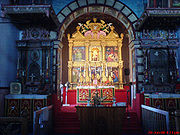 Altar of the St. Mary's Church in Kottayam; also can be seen are two Persian crosses from 7th century on either side; The church was originally built in 1550
Altar of the St. Mary's Church in Kottayam; also can be seen are two Persian crosses from 7th century on either side; The church was originally built in 1550
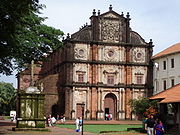 The Basilica of Bom Jesus completed in 1605 is considered one of the best examples of Baroque architecture in India
The Basilica of Bom Jesus completed in 1605 is considered one of the best examples of Baroque architecture in India
 Se Cathedral is one of the oldest and most celebrated religious buildings in Goa and is one of the largest churches in Asia.
Se Cathedral is one of the oldest and most celebrated religious buildings in Goa and is one of the largest churches in Asia.
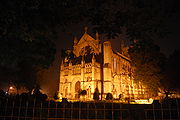 All Saints Cathedral, Allahabad built in 1887 is one of the finest examples of Gothic Revival architecture in India.
All Saints Cathedral, Allahabad built in 1887 is one of the finest examples of Gothic Revival architecture in India.
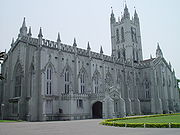 The tower of St. Paul's Cathedral, Kolkata was rebuilt along the lines of the Bell Harry Tower of Canterbury Cathedral following the 1934 Calcutta earthquake
The tower of St. Paul's Cathedral, Kolkata was rebuilt along the lines of the Bell Harry Tower of Canterbury Cathedral following the 1934 Calcutta earthquake
The ornate monumentality of the European churches was introduced to India when parts of Malabar Coast came under the jurisdiction of the Portuguese in the 16th century. They introduced the Romano-Portuguese style, which was assimilated with such artistic and structural finesse by the artists of Kerala, that it created some of the finest pieces of artistry. This laid the foundations for Indian Baroque.[67] After the arrival of Vasco da Gama and more especially after the commencement of Portuguese rule in India, distinct patterns of Christian art developed within the areas of Portuguese influence, mostly along the coasts of the peninsula. The Portuguese were great builders and promoted architecture more than any other form of fine art. St. Francis Church, Kochi is the first European place of worship in India and incidentally also the place where Vasco da Gama was first buried. The Christian art of Goa reached its climax in church building.[67]
Indian Christian art and architecture during the British Raj has expanded into several different styles as a result of extensive church building in different parts of the country. The style that was most patronized is generally referred to as the British Regency style which included Neo-Gothic and Gothic Revival architecture.[69] Most Protestant cathedrals and churches in India conform to this style. St. Paul’s Cathedral, Kolkata is a typical example of the Gothic Revival style. St. Mary’s church, Chennai, the first Anglican Church built east of the Suez is one of the first examples of British colonial architecture in India.[70] French and Danish influences on Christian art and architecture in India can be seen in their respective colonies.[71] Today one can see a harmonious blending of the East and the West in the Christian art and architecture of India.[68]
Culture
 St. Mary's Church, Secunderabad decorated in preparation for Midnight Mass on Christmas
St. Mary's Church, Secunderabad decorated in preparation for Midnight Mass on Christmas
While Christians in India do not share one common culture, it is for the most part a blend of Indian and European cultures. It differs from one region to another depending on several factors such as the prevailing rite and tradition and the extent of time for which Christianity has existed in those regions. The St. Thomas Christians of Kerala (the first region in India to be proselytized by Christian missionaries) have a distinctively different culture when compared to Christians in other parts of the country.[72] Historical ties with the Syriac Orthodox Church and assimilation of Indian traditions have contributed to the development a unique culture among Kerala’s Christians.[72] The use of ornamental umbrellas for Christian religious festivities illustrates the indigenous character of Kerala’s Christianity.[73]
Goa was colonized by the Portuguese in 16th century AD; as a result of which Goan Chrisitans have adopted a more western culture.[74] The dance, song and cuisine of Goa has been greatly influenced by the Portuguese.[75] Contemporary Goan Christian culture can be best described as an increasingly anglicized Indo-Latin culture.[76] Mangalorean Catholics are descended mainly from the Goan Catholic settlers, who had migrated to South Canara from Goa, a state north of Canara, between 1560 and 1763 during the Goa Inquisition and the Portuguese-Maratha wars. After migration to Mangalore, they adopted the local Mangalorean culture, but retained many of their Goan customs and traditions.[77] Christianity in other parts of India spread under the colonial regimes of the Dutch, Danish, French and most importantly the English from the early 17th century to the time of the Indian Independence in 1947. Christian culture in these colonial territories has been influenced by the religion and culture of their respective rulers.[78]
Contemporary Christian culture in India draws greatly from the Anglican culture as a result of the influence of the erstwhile British Raj. The Anglican Book of Common Prayer is a widely used supplement for worship in the two major Protestant denominations: Church of South India and Church of North India.[79] Today Christians are considered to be one of the most progressive communities in India.[80] Urban Christians are to a greater extent influenced by European traditions which is considered an advantage in the business environment of urban India; this is given as an explanation for the large number of Christian professionals in India's corporate sector.[81] The Christian church runs thousands of educational institutions which have contributed to the strengthening of Christian culture in India.
Religion plays a significant role in the daily life of Indian Christians. India ranks 15 among countries with highest church attendance. Religious processions and carnivals are often celebrated by Catholics.[82] Cities with significant Christian populations celebrate patron saint days. As in other parts of the world, Christmas is the most important festival for Indian Christians. Anglo-Indian Christmas balls held in most major cities form a distinctive part of Indian Christian culture.[83] Good Friday is a national holiday. All Souls Day is another Christian holiday that is observed by most Christians in India.[84] Most Protestant churches celebrate harvest festivals, usually in late October or early November.[85] Christian weddings in India conform to the traditional white wedding. However it is not uncommon for Christian brides particularly in the south to wear a traditional white wedding sari instead of a gown.[86] The vast majority of Protestant women and to a lesser extent Catholic women in India do not wear the bindi (red dot on the forehead) and can therefore be easily distinguished from their Hindu counterparts.[87]
Prominent Indian Christians
Main article: List of notable Indian ChristiansGovernment and politics Sonia Gandhi Current President of the Indian National Congress Party and chairperson of the ruling United Progressive Alliance. She was named the third most powerful woman in the world by Forbes magazine in the year 2004[88] A.K.Antony Current Defense Minister in UPA Government and Former Chief Minister of Kerala P.C. Alexander Governor of Tamil Nadu from 1988 to 1990 and Governor of Maharashtra from 1993 to 2002.[8] Margaret Alva Governor of Indian state of Uttarakhand from July 2009[89] George Fernandes Founder member of the Janata Dal (United) party and defence minister in the National Democratic Alliance (India) Government (1998–2004)[90] Ajit Jogi First Chief Minister of the state of Chhattisgarh Oscar Fernandes Minister of state (independent charge) of the Ministry of Labour and Employment in Dr. Manmohan Singh's first UPA government in India.[91] Y. S. Rajasekhara Reddy Chief Minister of the Indian state of Andhra Pradesh from 2004 to 2009.[92] Oommen Chandy Chief Minister of Kerala from 2004 to 2006 and 2011 – 2016 Incumbent P. A. Sangma Former Speaker of Lok Sabha and Chief Minister of Meghalaya.[93] Agatha Sangma Minister of State (the youngest) in the current Cabinet.[94] James Michael Lyngdoh Chief Election Commissioner of India from 2001 to 2004. He was also awarded the Ramon Magsaysay Award[95] Francisco Sardinha Chief Minister of Goa from 24 November 1999 to 24 October 2000[96] Albert Ekka A soldier in the Indian army who was awarded Param Vir Chakra. Sunith Francis Rodrigues Chief of Army Staff of the Indian Army from 1990 to 1993 and the current Governor of the Indian State of Punjab[97] Oscar Dawson Former Chief of Naval Staff of India[98] Anna Chandy First woman judge in India and probably the second in the world to reach a high court judgeship in 1959.[99] St. Alphonsa's birth centenary commemorative coin released by the Reserve Bank of India in 2010
Religion Mother Teresa Founder of the Missionaries of Charity in Kolkata, India in 1950. She was of Albanian Catholic origin.[100] St. Alphonsa First Indian woman to be canonized as a saint in the Roman Catholic Church.[101] St. Gonsalo Garcia First Roman Catholic saint from India[102] Ivan Dias Current Prefect of the Congregation for the Evangelization of Peoples in the Roman Curia[103] Telesphore Toppo First Adivasi (tribal) Indian to be created a Cardinal in the Roman Catholic Church[104] St. Gregorios First canonized saint in India, venerated both in the Malankara Orthodox Syrian Church and the Jacobite Syrian Orthodox Church[105] Pandita Ramabai Social reformer and founder of the Pandita Ramabai Mukti Mission.[106] Varghese Payapilly Palakkappilly Founder of the Congregation of the Sisters of the Destitute[107] Arts, sports and cinema Mala Sinha Indian actress of popular fame from the fifties to the early seventies. Kalpana Kartik Indian actress of the 1950s and wife of actor and film maker Dev Anand.[108] J. C. Daniel Indian film-maker considered to be the father of Malayalam cinema. He produced, directed, wrote, photographed, edited and acted in the first film made in Kerala, named Vigathakumaran meaning the Lost Child. Sheela Malyali film actress and a National Film Award winner who along with Prem Nazir, holds the world record for acting in the largest number of films (107) together as heroine and hero.[109] Frieda Pinto Indian actress and professional model best known for her performance as Latika in her debut film Slumdog Millionaire[110] Diana Hayden Indian model, actor and former Miss World.[111] Lara Dutta Indian actress, UNFPA Goodwill Ambassador and former Miss Universe 2000.[112] Leander Paes Indian professional tennis player who currently features in the doubles events in the ATP tour and the Davis Cup tournament[113] Mahesh Bhupathi Indian professional tennis player widely regarded as among the best doubles players in the world with 11 Grand Slam titles to his credit.[114][115] Viren Rasquinha Former captain of India's national field hockey team that finished seventh at the 2004 Summer Olympics in Athens[116] Robin Uthappa Indian cricketer who currently plays for Pune Warriors India in the Indian Premier League. Paul Valthaty Indian cricketer who currently plays for Kings XI Punjab in the Indian Premier League.[117] Dino Morea Indian actor and former model[118] Wendell Rodricks The first Indian designer to open the Dubai Fashion Week. Genelia D'Souza Indian film actress, model, and host[119] Amala Paul Indian film actress, model, and host[120] Asin Thottumkal Indian film actress, model, and host[121] Demographics
Part of a series on Christianity
in India
Background People - St. Thomas the Apostle
- St. Francis Xavier
- St. Gonsalo Garcia
- Devasahayam Pillai
- St. Alphonsa Muttathupadam
- Thomas of Cana
- Mother Teresa
- Palackal Thoma Malpan
- Mar Augustine Kandathil
- Mar Sapor and Prodh
- Marthoma Metrans
- St. Gregorios of Parumala
- St. Baselios Eldho
- Fr. Kuriakose Elias Chavara
- Fr. Varghese Payapilly Palakkappilly
- Mgr. Joseph C. Panjikaran
- William Carey
Churches - St. Thomas Christians:
- Malankara (historical)
- Chaldean Syrian
- Jacobite Syrian
- Malankara Orthodox Syrian
- Malabar Independent Syrian
- Mar Thoma
- St. Thomas Evangelical
- Syro-Malabar Catholic
- Syro-Malankara Catholic
- Latin Rite:
- Latin Catholic
- Protestant denominations:
- Andhra Evangelical Lutheran
- Church of North India
- Church of South India
- Garo Baptist
- Pentecostal Church of God
- North Bank Baptist Christian
- Northern Evangelical Lutheran
- Presbyterian
- The Pentecostal Mission
- Seventh-day Adventist
- True Jesus
- United Evangelical Lutheran
Indian Christianity portal Distribution of Christian population in different Indian states[122]
The total number of Christians in India as per Census in 2001 are 24,080,016 or 2.34% of the population.[2]
The majority of Indian Christians are Roman Catholics accounting for a total of 17.3 million members,[123] including 500,000 members of the Syro-Malankara Church[124] and 3,900,000 of the Syro-Malabar Church. In January 1993, the Syro-Malabar Church and in February 2005, the Syro-Malankara Church were raised to the status of major archiepiscopal churches by Pope John Paul II. The Syro-Malabar Church is the second largest among the twenty two Eastern Catholic Churches who accept the Pope as the visible head of the whole church.
The Oriental Orthodox churches in India include the Malankara Jacobite Syrian Church with 900,000 members and the Indian Orthodox Church with 1,200,000 members.[125]
Most Protestant denominations are represented in India, as a result of missionary activities throughout the country, such as the American Missionary Association, the Society for the Propagation of the Gospel Mission, the Church Mission Society of the Church Of England and many other missions from Europe, America and Australia. With approximately 3.8 million members, the largest Protestant denomination in the country is the Church of South India, which is a union of Presbyterian, Reformed, Congregational, Methodist, and Anglican congregations. It is also one of four united churches in the Anglican Communion.[126] A similar Church of North India has 1.25 million members.[127] These churches are in full communion with the Anglican Communion. The Mar Thoma Church with 700,000 members is also in communion with the Anglicans, but is not a full member.[128] In 1961, the evangelical wing of the church split from the Mar Thoma Church and formed the St. Thomas Evangelical Church of India which has 10,000 members.[129] There are about 1,267,786 Lutherans,[130] 648,000 Methodists,[131] 2,392,694 Baptists,[132] and 823,456 Presbyterians in India.[133] The Brethren denomination is also significantly represented in India. They are known by different names such as the Plymouth Brethren, the Indian Brethren, and the Kerala Brethren.
Pentecostalism is also a rapidly growing in India. The major Pentecostal churches in India are the Assemblies of God, the Pentecostal Mission,[134][135] the Indian Pentecostal Church of God with 900,000 members,[136] the New Apostolic Church with 1,448,209 members,[136] the New Life Fellowship Association with 480,000 members, the Manna Full Gospel Churches with 275,000 members,[136] and the Evangelical Church of India with 250,000 members.[137]
From the late 19th century, the fastest growing Christian communities have been located in the northeast, in the Seven Sister States, among the Khasis, Mizos, and the Nagas. Today Christians are most prevalent in the northeast, and in the southwestern states of Kerala and Goa. The states of Kerala and Tamil Nadu in South India and Nagaland, Mizoram and Meghalaya in North-East India account for 60% of India's total Christian population.[138]
Christian Denominations in India Church Name Population Orientation Catholic Church 11,800,000 Roman Catholic-Latin Rite Syro-Malabar Church 3,947,396[139] Roman Catholic-East Syrian Rite Syro-Malankara Church 500,000 Roman Catholic-West Syrian Rite Malankara Jacobite Syrian Orthodox Church 900,000 Oriental Orthodox Malankara Orthodox Syrian Church 1,600,000 Oriental Orthodox Malabar Independent Syrian Church 35,000 Oriental Orthodox Chaldean Syrian Church 30,000 Church of the East Malankara Mar Thoma Syrian Church 900,000 (Approx)[140] Oriental Reformed Church of South India 3,800,000 Protestant Church of North India 1,250,000 Protestant Methodist Church in India 648,000 Protestant Baptist 2,392,694 Protestant Lutheran 1,267,786[130] Protestant Indian Brethren 1,000,000 Protestant Presbyterian Church of India 823,456 Protestant St. Thomas Evangelical Church 30,000 Protestant Worldwide Faith Missions 12,000 Protestant Evangelical Church[disambiguation needed  ]
]250,000 Protestant New Apostolic Church[136] 1,448,209 Protestant India Pentecostal Church of God 600,000 Protestant New Life Fellowship Association[136] 480,000 Protestant Manna Full Gospel Churches[136] 275,000 Protestant Philadelphia Fellowship Church of India[136] 200,000 Protestant Unitarian Union of Northeast India 10,000 Unitarian Jehovah's Witnesses 33,089[141] Restorationism States with significant percentage of Christians as per 2001 census State Population Christian (%) Christian (numbers)  India
India1,028,610,328 2.3 24,080,016 Mizoram 889,000 90.5 804,545 Nagaland 1,990,000 90.0 1,791,398 Meghalaya 2,319,000 70.3 1,630,257 Manipur 2,294,000 34.0 779,960 Goa 1,343,998 26.0 349,439 Andaman and Nicobar Islands 356,152 21.7 77,178 Kerala 31,841,000 19.0 6,049,790 Arunachal Pradesh 1,097,968 18.7 205,548 Puducherry 974,345 7.0 67,688 Sikkim 540,851 6.6 36,115 Tamil Nadu 62,405,679 6.06 3,785,060 Jharkhand 26,945,829 4.05 1,093,382 Assam 26,655,528 3.7 986,589 Tripura 3,199,203 3.2 102,489 Orissa 36,804,660 2.4 897,861 Karnataka 52,850,562 2.0 1,009,164 Andhra Pradesh 76,210,007 1.5 1,181,917 Maharashtra 96,878,627 1.09 1,058,313 Caste Demographic data reported by the Sachar Committee on Muslim Affairs in 2006[142] Religion Scheduled Caste Scheduled Tribe Other Backward Class Other Caste Buddhism 89.50% 7.40% 0.4% 2.7% Sikhism 30.70% 0.90% 22.4% 46.1% Hinduism 22.20% 9.10% 42.8% 26% Christianity 9.00% 32.80% 24.8% 33.3% Islam 0.80% 0.50% 39.2% 59.5% Conflicts
Hindu-Christian conflict
 Pope John Paul II with M. G. Ramachandran on his visit to Madras in 1984
Pope John Paul II with M. G. Ramachandran on his visit to Madras in 1984
Historically, Hindus and Christians have lived in relative peace since the arrival of Christianity in India from the early part of the first millennium. In areas where Christianity existed in pre-European times like Kerala, land to build churches was often donated by Hindu kings and Hindu landlords. The arrival of European colonialists brought about large scale missionary activity in South India and North-East India. Many indigenous cultures were converted to Christianity, sometimes voluntary, and other times through the use of coercion.[citation needed] The Goan Inquisition is pointed out as a blot in the history of Goa. In more contemporary periods, Hindu-Christian amity continues to exist.
 A church that has been burnt down during the 2008 Religious violence in Orissa
A church that has been burnt down during the 2008 Religious violence in Orissa
There has been an increase in anti-Christian violence in recent years particularly in the states of Gujarat and Orissa; which is usually perpetrated by Hindu nationalists. The acts of violence include arson of churches, re-conversion of Christians to Hinduism by force and threats of physical violence, distribution of threatening literature, burning of Bibles, raping of nuns, murder of Christian priests and destruction of Christian schools, colleges, and cemeteries.[143][144] An Australian missionary Graham Staines and his two sons were torched alive while sleeping on 22 January 1999 in Orissa. According to some, the number of incidents of anti-Christian violence has multiplied since the Hindu nationalist Bharatiya Janata Party (BJP) began its rule in March 1998.[144] Vishva Hindu Parishad (VHP), Bajrang Dal, and Rashtriya Swayamsevak Sangh are generally held responsible for violence against Christians in India.[144] Sangh Parivar and local media were involved in promoting anti-Christian propaganda in Gujrat.[144] In its annual human rights reports for 1999, the United States Department of State criticised India for "increasing societal violence against Christians."[145] The report on anti-Christian violence listed over 90 incidents of anti-Christian violence, ranging from damage of religious property to violence against Christians pilgrims. As a response to allegedly aggressive missionary activity four Indian states Rajasthan, Madhya Pradesh, Himachal Pradesh, and Tamil Nadu (later repealed) have passed laws restricting or prohibiting religious conversion.[146][147]
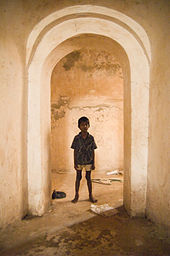 Many Mangalorean Catholics who refused to embrace Islam were imprisoned into such dungeons at Seringapatam
Many Mangalorean Catholics who refused to embrace Islam were imprisoned into such dungeons at Seringapatam
Muslim-Christian conflict
 The Jamalabad fort route. Mangalorean Catholics had traveled through this route on their way to Seringapatam
The Jamalabad fort route. Mangalorean Catholics had traveled through this route on their way to Seringapatam
In spite of the fact that there have been relatively fewer conflicts between Muslims and Christians in India in comparison to those between Muslims and Hindus, or Muslims and Sikhs, the relationship between Muslims and Christians have also been occasionally turbulent. With the advent of European colonialism in India throughout the 16th, 17th and 18th centuries, Christians were systematically persecuted in a few Muslim ruled kingdoms in India.
Perhaps the most infamous acts of anti-Christian persecution by Muslims was committed by Tippu Sultan, the ruler of the Kingdom of Mysore against the Mangalorean Catholic community from Mangalore in the erstwhile South Canara district on the southwestern coast of India. Tippu was widely reputed to be anti-Christian. The Captivity of Mangalorean Catholics at Seringapatam, which began on 24 February 1784 and ended on 4 May 1799, remains the most disconsolate memory in their history.[148]
The Bakur Manuscript reports him as having said: "All Musalmans should unite together, considering the annihilation of infidels as a sacred duty, and labor to the utmost of their power, to accomplish that subject."[149] Soon after the Treaty of Mangalore in 1784, Tippu gained control of Canara.[150] He issued orders to seize the Christians in Canara, confiscate their estates,[151] and deport them to Seringapatam, the capital of his empire, through the Jamalabad fort route.[152] However, there were no priests among the captives. Together with Fr Miranda, all the 21 arrested priests were issued orders of expulsion to Goa, fined Rs 2 lakhs, and threatened death by hanging if they ever returned.[149]
Tippu ordered the destruction of 27 Catholic churches, all beautifully carved with statues depicting various saints. Among them were Nossa Senhora de Rosario Milagres at Mangalore, Fr Miranda's Seminary at Monte Mariano, Jesu Marie Jose at Omzoor, the Chapel at Bolar, the Church of Merces at Ullal, Imaculata Conceiciao at Mulki, San Jose at Perar, Nossa Senhora dos Remedios at Kirem, Sao Lawrence at Karkal, Rosario at Barkur, and Immaculata Conceciao at Baidnur.[149] All were razed to the ground, with the exception of the Church of Holy Cross at Hospet, owing to the friendly offices of the Chauta Raja of Moodbidri.[153]
According to Thomas Munro, a Scottish soldier and the first collector of Canara, around 60,000 people,[154] nearly 92 percent of the entire Mangalorean Catholic community, were captured, of which only 7,000 escaped. Francis Buchanan states the numbers as 70,000 captured, from a population of 80,000, with 10,000 escaping. They were forced to climb nearly 4,000 feet (1,200 m) through the jungles of the Western Ghat mountain ranges. It was 210 miles (340 km) from Mangalore to Seringapatam, and the journey took six weeks. According to British Government records, 20,000 of them died on the march to Seringapatam. According to James Scurry, a British officer, who was held captive along with the Mangalorean Catholics, 30,000 of them were forcibly converted to Islam. The young women and girls were forcibly made wives of the Muslims living there.[155] The young men who offered resistance were disfigured by cutting their noses, upper lips, and ears.[156] According to Mr. Silva of Gangolim, a survivor of the captivity, if a person who had escaped from Seringapatam was found, the punishment under the orders of Tippu was the cutting off of the ears, nose, the feet and one hand.[157]
The Archbishop of Goa wrote in 1800, "It is notoriously known in all Asia and all other parts of the globe of the oppression and sufferings experienced by the Christians in the Dominion of the King of Kanara, during the usurpation of that country by Tipu Sultan from an implacable hatred he had against them who professed Christianity."[149]
Tippu Sultan's invasion of the Malabar had an adverse impact on the Syrian Malabar Nasrani community of the Malabar coast. Many churches in the Malabar and Cochin were damaged. The old Syrian Nasrani seminary at Angamaly which had been the center of Catholic religious education for several centuries was razed to the ground by Tippu’s soldiers. A lot of centuries old religious manuscripts were lost forever. The church was later relocated to Kottayam where it still exists to this date. The Mor Sabor church at Akaparambu and the Martha Mariam Church attached to the seminary were destroyed as well. Tippu’s army set fire to the church at Palayoor and attacked the Ollur Church in 1790. Furthernmore, the Arthat church and the Ambazhakkad seminary was also destroyed. Over the course of this invasion, many Syrian Malabar Nasrani were killed or forcibly converted to Islam. Most of the coconut, arecanut, pepper and cashew plantations held by the Syrian Malabar farmers were also indiscriminately destroyed by the invading army. As a result, when Tippu's army invaded Guruvayur and adjacent areas, the Syrian Christian community fled Calicut and small towns like Arthat to new centres like Kunnamkulam, Chalakudi, Ennakadu, Cheppadu, Kannankode, Mavelikkara, etc. where there were already Christians. They were given refuge by Sakthan Tamburan, the ruler of Cochin and Karthika Thirunal, the ruler of Travancore, who gave them lands, plantations and encouraged their businesses. Colonel Macqulay, the British resident of Travancore also helped them.[158]
His persecution of Christians also extended to captured British soldiers. For instance, there were a significant amount of forced conversions of British captives between 1780 and 1784. Following their disastrous defeat at the battle of Pollilur, 7,000 British men along with an unknown number of women were held captive by Tipu in the fortress of Seringapatnam. Of these, over 300 were circumcised and given Muslim names and clothes and several British regimental drummer boys were made to wear ghagra cholis and entertain the court as nautch girls or dancing girls. After the 10 year long captivity ended, James Scurry, one of those prisoners, recounted that he had forgotten how to sit in a chair and use a knife and fork. His English was broken and stilted, having lost all his vernacular idiom. His skin had darkened to the swarthy complexion of negroes, and moreover, he had developed an aversion to wearing European clothes.[159] During the surrender of the Mangalore fort which was delievered in an armistice by the British and their subsequent withdrawal, all the Mestizos and remaining non-British foreigners were killed, together with 5,600 Mangalorean Catholics. Those condemned by Tipu Sultan for treachery were hanged instantly, the gibbets being weighed down by the number of bodies they carried. The Netravati River was so putrid with the stench of dying bodies, that the local residents were forced to leave their riverside homes.[149]
In modern times, Muslims in India who convert to Christianity are often subjected to harassment, intimidation, and attacks by Muslims. In Kashmir, the only Indian state with a Muslim majority, a Christian convert and missionary named Bashir Tantray was killed , allegedly by militant Islamists in 2006.[160]
A Christian priest, K.K. Alavi, who is a convert from Islam, recently raised the ire of his former Muslim community and has received many death threats. An Islamic extremist group named the National Development Front actively campaigned against him.[161]
See also
Christianity by Country
North AmericaSouth AmericaOceania- List of notable Indian Christians
- Church of South India
- List of cathedrals in India
- List of Roman Catholic missionaries in India
- List of Protestant missionaries in India
- History of Pentecostalism in India
- Christianity in Goa
- Christianity in West Bengal
- Christianity in Tamil Nadu
- Christianity in Kerala
- Telugu Christian
- Christianity in Maharashtra
References
- ^ 2001 census data – Government of India
- ^ a b "Census of India, 2001". Census Bureau, Government of India.. 2001. http://www.censusindia.gov.in/Census_Data_2001/Census_Data_Online/Social_and_cultural/Religion.aspx.
- ^ a b Medlycott, A E. 1905 "India and the Apostle Thomas"; Gorgias Press LLC
- ^ Thomas Puthiakunnel, (1973) "Jewish colonies of India paved the way for St. Thomas", The Saint Thomas Christian Encyclopedia of India, ed. George Menachery, Vol. II.
- ^ "Kerala Syrian Christians, Apostle in India". nasrani.net. http://nasrani.net/2007/02/13/kerala-syrian-christian-the-tomb-of-the-apostle-persian-church-syond-of-diamper-coonan-cross-oath-divisions/. Retrieved 2009-10-25.
- ^ "Jesus trail in India". The Hindu (India). 2007-11-20. http://www.hindu.com/2007/11/20/stories/2007112058852200.htm.
- ^ Jesus in India | Tomb of Jesus | Where Did Jesus Die | Jesus in Islam – Al Islam Online
- ^ a b Hon'ble Shri P. C. Alexander
- ^ Govt appoints new Governors, Margaret Alva gets Uttarakhand
- ^ Census of India, Religious composition by gender, India... at GeoCommons
- ^ National Minority Status For Jain Community In India |
- ^ Census of India : Salient Features
- ^ Abraham Vazhayil Thomas (1974). Christians in Secular India. Fairleigh Dickinson University Press. pp. 13,200. ISBN 0838610218.
- ^ Stephen Andrew Missick. "Mar Thoma: The Apostolic Foundation of the Assyrian Church and the Christians of St. Thomas in India" (PDF). Journal of Assyrian Academic studies. http://www.jaas.org/edocs/v14n2/missick.pdf.
- ^ NSC NETWORK – Early references about the Apostolate of Saint Thomas in India, Records about the Indian tradition, Saint Thomas Christians & Statements by Indian Statesmen
- ^ kuzhippallil Nasrani Syrian Christians
- ^ Eusebius of Caesarea, Historia Ecclesiastica5. 9–10. Pantaenus, who was known by Clement of Alexandria (Eusebius Historia Ecclesiastica 5.11.1–2; 6.13.2) and Origen (Eusebius, Historia Ecclesiastica 6.14.8), was certainly a historical person.
- ^ a b c d e A.E. Medlycott, India and The Apostle Thomas, pp.18–71 M.R. James, Apocryphal New Testament, pp.364–436 A.E. Medlycott, India and The Apostle Thomas, pp.1–17, 213–97 Eusebius, History, chapter 4:30 J.N. Farquhar, The Apostle Thomas in North India, chapter 4:30 V.A. Smith, Early History of India, p.235 L.W. Brown, The Indian Christians of St. Thomas, p.49-59
- ^ a b Stephen Neill (2004). A History of Christianity in India: The Beginnings to Ad 1707. Cambridge University Press. p. 29. ISBN 0521548853.
- ^ Dr. Issac Arul Dhas G,``Kumari Mannil Christhavam` (Tamil), Scott Christian College, Nagercoil, 2010, ISBN 978-81-8465-204-8, Page 7
- ^ Dr. Issac Arul Dhas, `Kumari Mannil Christhavam`(Tamil), ISBN 978-81-8465-204-8, Page 7.
- ^ http://www.gnosis.org/thomasbook/ch5.html
- ^ http://www.oration.com/~mm9n/articles/marthoma/index.htm
- ^ http://www.piney.com/ApocActsThomas.html
- ^ Baum, Wilhelm; Dietmar W. Winkler (2003). The Church of the East: A Concise History. Routledge. p. 53. ISBN 9780415297707. ISSN 0415297702. http://books.google.com/?id=sRO4soRjVkYC. Retrieved 2 March 2009.
- ^ Missick, Stephen Andrew (2000). "Mar Thoma: The Apostolic Foundation of the Assyrian Church and the Christians of St. Thomas in India". Journal of Assyrian Academic Studies XIV (2): 33–61. http://www.aina.org/articles/missick.pdf. Retrieved 2 March 2009.
- ^ Neill, Stephen (2004). A History of Christianity in India. Cambridge University Press. p. 41. ISBN 0521548853. http://books.google.com/?id=dbVNvsZWH5EC.
- ^ Manuscript volume dated 1604 AD kept in British Museum
- ^ K.S. Latourette, A History of the Expansion of Christianity, 7 vols., London, 1940–49
- ^ Edward Gibbon, The Decline and Fall of the Roman Empire, London, 1957
- ^ Koenraad Elst, Negationism in India: Concealing the Record of Islam, New Delhi, 1992,
- ^ T.R. Vedantham, "St. Thomas Legend" in the South Madras News, Madras, 1987
- ^ Ishwar Sharan, The Myth of Saint Thomas and the Mylapore Shiva Temple, New Delhi, 1995
- ^ a b c d James R. Lewis (2003). Legitimating New Religions. Rutgers University Press. p. 75. ISBN 0813533244.
- ^ Rice, Edward (1978). Eastern Definitions: A Short Encyclopedia of Religions of the Orient. New York. p. 7. ISBN 0-385-08563-X
- ^ Goodspeed, Edgar J. (1956). Famous Biblical Hoaxes or, Modern Apocrypha. Grand Rapids, Michigan: Baker Book House. http://www.tentmaker.org/books/FamousBiblicalHoaxes.html.. See also [1]
- ^ James R. Lewis (2003). Legitimating New Religions. Rutgers University Press. p. 78. ISBN 0813533244.
- ^ Ehrman, Bart D. (February 2011). "8. Forgeries, Lies, Deceptions, and the Writings of the New Testament. Modern Forgeries, Lies, and Deceptions" (EPUB). Forged: Writing in the Name of God—Why the Bible’s Authors Are Not Who We Think They Are. (First Edition. EPub ed.). New York: HarperCollins e-books. pp. 282–283. ISBN 978-0-06-207863-6. http://www.scribd.com/doc/55685655/Forged. Retrieved 8 September 2011.
- ^ Syrian Christians of Kerala- SG Pothen- page 32-33 (1970)
- ^ Anglo Saxon Chronicle Part II, AD 750–919
- ^ Marco Polo. The Book of Travels. page 287.
- ^ http://markdroberts.com/htmfiles/resources/jesuslanguage.htm
- ^ Podipara, Placid J. (1970) "The Thomas Christians". London: Darton, Longman and Tidd, 1970. (is a readable and exhaustive study of the St. Thomas Christians.)
- ^ Leslie Brown, (1956) The Indian Christians of St. Thomas. An Account of the Ancient Syrian Church of Malabar, Cambridge: Cambridge University Press 1956, 1982 (repr.)
- ^ "Christianity in India". M.B. Herald, Vol. 35, No. 9. http://old.mbconf.ca/mb/mbh3509/christin.htm. Retrieved 2008-03-13.
- ^ Asia and Western Dominance: A Survey of the Vasco Da Gama Epoch of Asian History, 1498–1945. :23. The Pacific Historical Review. 1954-11-04. pp. 407–408. ISBN 0049500058.
- ^ a b "The greate prelates who shaped the history of diocese of quilon". Quilon Diocese. Archived from the original on 2007-11-03. http://web.archive.org/web/20071103162915/http://www.quilondiocese.org/former+prelates+of+diocese.htm. Retrieved 2008-01-17.
- ^ See full text pp.13–20 (Latin) and pp.20–26 (English) in European Treaties Bearing on the History of the United States and Its Dependencies to 1648, Washington, D.C., Frances Gardiner Davenport, Carnegie Institution of Washington, 1917–37 – Google Books. Reprint edition, 4 vols., (October 2004),Lawbook Exchange, ISBN 1-58477-422-3
- ^ Daus, Ronald (1983). Die Erfindung des Kolonialismus. Wuppertal/Germany: Peter Hammer Verlag. p. 33. ISBN 3-87294-202-6.(German)
- ^ a b Factfile: Roman Catholics around the world on BBC news.
- ^ Megan Galbraith Catholic Church of India Responds with Leadership Field note on Glocal Health Council website.
- ^ Vasco da Gama collection on University of Michigan
- ^ a b Daus, Ronald (1983). Die Erfindung des Kolonialismus. Wuppertal/Germany: Peter Hammer Verlag. pp. 61–66. ISBN 3-87294-202-6.(German)
- ^ Paul Axelrod, Michelle A. Fuerch Flight of the Deities: Hindu Resistance in Portuguese Goa Modern Asian Studies, Vol. 30, No. 2 (May, 1996), pp. 387–421
- ^ Frykenberg, p. 93.
- ^ Wilmshurst, EOCE, 343
- ^ a b Synod of Diamper on Synod of Diamper Church website.
- ^ Gazetteers Of The Bombay Presidency – Thana
- ^ "East Indians (the indigenous Catholic inhabitants of Bombay, Salsette and Bassein)" (PDF). The East Indian Community. http://www.east-indians.com/history.pdf. Retrieved 2008-03-02.
- ^ William Carey
- ^ The Hindu : Magazine / Tribute : The legacy that Ziegenbalg left
- ^ Eugene Myers Harrison. "William Carey (The Cobbler Who Turned Discoverer)". Wholesome Words. http://www.wholesomewords.org/missions/giants/biocarey2.html. Retrieved 2008-03-02.
- ^ Canadian Baptist mission work among women in Andhra, India, 1874–1924: Baptist women evolved a role for themselves in an otherwise male-dominated mission enterprise and a patr...
- ^ John C F Heyer, Missionary
- ^ http://fultonhistory.com/newspaper%2010/Carmel%20NY%20Putnam%20Country%20Courier/Carmel%20NY%20Putnam%20Country%20Courier%201931%20Grayscale/Carmel%20NY%20Putnam%20Country%20Courier%201931%20Grayscale%20-%200127.pdf
- ^ American Baptist Foreign Mission Society, Tour of Assam, 1960
- ^ a b c d e Art Architecture India Christian Kerala Syrian Christianity
- ^ a b c http://thinkers.net/writer/Keralart.html
- ^ Singh et al 2007, p. 69.
- ^ Monuments in Chennai,Monuments of Chennai India,Monuments Tour in Chennai,Chennai Monuments Tours,Travel to Chennai Monuments,Chennai Monuments Holidays
- ^ French architecture, Pondicherry, Mamallapuram, India
- ^ a b The Culture of Kerala
- ^ Welcome To Indian Christianity
- ^ Pidgins and Creoles: References survey – Google Books
- ^ Goa Culture, Goa Culture Guide, Goa India Culture Information: India Line Travel
- ^ Goan Catholic
- ^ [2][dead link]
- ^ EN-DANÉS _____ foro creado por Blanca Ortiz – Tranquebar: a Danish town in India – Viajes y sitios
- ^ The Book of Common Prayer
- ^ Indian Christians Treat Their Women Better, Sex Ratio Highest
- ^ Global Perspective: India's Christian identity
- ^ Origin of Goa Carnival
- ^ "Anglo-Indians mark Christmas with charity". The Times Of India (India). 2008-12-26. http://timesofindia.indiatimes.com/city/bangalore/Anglo-Indians-mark-Christmas-with-charity/articleshow/3892370.cms.
- ^ Mangalorean.Com- Serving Mangaloreans Around The World!
- ^ [3][dead link]
- ^ Christian Wedding,Christian Wedding Customs,Christian Wedding Rituals India
- ^ http://www.adventistmission.org/article.php?id=622
- ^ Sonia Gandhi 3rd most powerful woman. Retrieved on 23 March 2007.
- ^ Governor of Indian state of Uttarakhand from July 2009
- ^ Former Defense Minister George Fernandes in Israel arms deal probe | India Defence
- ^ [4][dead link]
- ^ "Profile: YSR Reddy". Zee News. 2009-09-02. http://www.zeenews.com/news560356.html. Retrieved 2009-09-02.
- ^ The Office of Speaker Lok Sabha
- ^ "NCP retains Tura, Congress Shillong". The Hindu (Chennai, India). 2009-05-16. http://www.hindu.com/thehindu/holnus/002200905161632.htm. Retrieved 2009-05-25. "... NCP candidate Agatha Sangma, daughter of former Lok Sabha Speaker P A Sangma, retained the Tura parliamentary seat in Meghalaya and Congress the Shillong seat. Ms. Agatha, who is the sitting MP, polled 1,54,476 votes compared to 1,36,531 votes by closest rival Deborah Marak of the Congress. ..."
- ^ "Previous Chief Election Commissioners". Election Commission of India. http://www.eci.gov.in/Audio_VideoClips/previous-ces.asp.
- ^ "Detailed Profile: Francisco Sardinha". india.gov.in website. http://india.gov.in/govt/loksabhampbiodata.php?mpcode=3914. Retrieved 30 March 2010.
- ^ http://punjabassembly.nic.in/Members/governor.htm
- ^ Profile of Admiral O. S. Dawson[dead link]
- ^ "Women of Achievement". http://www.thelizlibrary.org/collections/woa/woa05-04.html. Retrieved 2008-05-27.
- ^ Online NewsHour: Mother Teresa Dies- 5 September 1997
- ^ AFP: Indian Catholics cheer their first woman saint
- ^ "St. Gonsalo Garcia". Catholic Encyclopedia. New York: Robert Appleton Company. 1913. http://www.newadvent.org/cathen/06379a.htm.
- ^ Ivan Cardinal Dias [Catholic-Hierarchy]
- ^ Untitled Document
- ^ Church Saints
- ^ Ramabai Mukti Mission
- ^ This website is currently unavailable
- ^ The Telegraph – Calcutta : Look
- ^ "Comeback queen". The Hindu (India). 2005-05-27. http://www.hindu.com/fr/2005/05/27/stories/2005052702800400.htm.
- ^ "Slumdog has done India proud, says Frieda's father". DNA. 2009-02-23. http://www.dnaindia.com/entertainment/report_slumdog-has-done-india-proud-says-frieda-s-father_1233560. Retrieved 2009-04-29.
- ^ #DianaHayden.com – The website owned by Diana Hayden
- ^ UNFPA Goodwill Ambassadors profile page, Available online
- ^ Leander Paes Biography and Olympic Results | Olympics at Sports-Reference.com
- ^ Sinh, Gauri (2002-09-02). "Shvetha & Mahesh? Why knot!". The Times Of India (India). http://timesofindia.indiatimes.com/city/delhi-times/Shvetha-Mahesh-Why-knot/articleshow/20992167.cms.
- ^ Mira Bhupathi’s Confession | NewsGrab
- ^ Mangalorean.Com- Serving Mangaloreans Around The World!
- ^ Youth Activ8 Foundation
- ^ Dino Morea
- ^ Genelia D'Souza at the Internet Movie Database
- ^ Amala Paul Biography | Tamil Actress | Fact File | Photo Gallery | Wallpapers | Videos | News | Oneindia.in
- ^ Asin, Actress Asin, Asin Tamil Actress, Asin Online, Asin Photo Gallery, Asin Wallpapers
- ^ Population by religious communities
- ^ "Factfile: Roman Catholics around the world". BBC News. 2005-04-01. http://news.bbc.co.uk/1/hi/world/4243727.stm. Retrieved 2010-01-02.
- ^ "Recapitulation of Statistics". The Syro-Malankara Catholic Major Archiepiscopal Church. http://www.malankaracatholicchurch.net/Statistics.htm.
- ^ Malankara Syriac Christian Resources – http://SyriacChristianity.org
- ^ Csi Synod
- ^ Address data base of Reformed churches and institutions
- ^ Indian Christianity
- ^ Adherents.com
- ^ a b Adherents.com: By Location
- ^ GBGM Feature
- ^ Baptist World Alliance – Statistics[dead link]
- ^ Indian Christianity
- ^ Critique Of Pentecostal Mission By A Friendly Evangelical
- ^ [5][dead link]
- ^ a b c d e f g http://www.apts.edu/ajps/01-1/01-1-SBurgess.pdf
- ^ Adherents.com: By Location
- ^ Census Reference Tables, C-Series Population by religious communities
- ^ NSC NETWORK – Population Statistics and Demography of Saint Thomas Christians, Churches with historical references
- ^ Mar Thoma Sabha Diary 2011. Page 9.
- ^ 2010 Report of Jehovah's Witnesses Worldwide From Official Website of Jehovah's Witnesses
- ^ untitled
- ^ Vinay Lal. "Anti-Christian Violence in India". Manas: India and Its Neighbors. UCLA College of Letters and Science. http://www.sscnet.ucla.edu/southasia/History/Current_Affairs/Current_affairs.html.
- ^ a b c d "Anti-Christian Violence on the Rise in India". Human Rights Watch. 29 September 1999. http://hrw.org/english/docs/1999/09/30/india1626.htm.
- ^ "US rights report slams India for anti-Christian violence". 1999-02-27. http://www.expressindia.com/news/ie/daily/19990227/ige27064.html. Retrieved 2007-12-17.
- ^ Bareth, Narayan (2005-02-23). "State to bar religious conversion". BBC News. http://news.bbc.co.uk/2/hi/south_asia/4290843.stm.
- ^ "Religious Conversions". The Times Of India (India). http://articles.timesofindia.indiatimes.com/keyword/religious-conversions/recent/5.
- ^ "Deportation & The Konkani Christian Captivity at Srirangapatna (1784 Feb. 24th Ash Wednesday)". Daijiworld Media Pvt Ltd Mangalore. http://www.daijiworld.com/chan/achievers_view.asp?a_id=28. Retrieved 2008-02-29.
- ^ a b c d e Sarasvati's Children, Joe Lobo
- ^ Forrest 1887, pp. 314–316
- ^ The Gentleman's Magazine 1833, p. 388
- ^ "Christianity in Mangalore". Diocese of Mangalore. http://www.dioceseofmangalore.org/history.asp. Retrieved 2008-07-30.[dead link]
- ^ John B. Monteiro. "Monti Fest Originated at Farangipet – 240 Years Ago!". Daijiworld Media Pvt Ltd Mangalore. http://www.daijiworld.com/chan/exclusive_arch.asp?ex_id=129. Retrieved 2009-04-28.
- ^ Bowring 1997, p. 126
- ^ Scurry & Whiteway 1824, p. 103
- ^ Scurry & Whiteway 1824, p. 104
- ^ Account of a Surviving Captive, A Mr. Silva of Gangolim (Letter of a Mr. L.R. Silva to his sister, a copy of which was given by an advocate, M.M. Shanbhag, to the author, Severino da Silva, and reproduced as Appendix No. 74: History of Christianity in Canara (1965))
- ^ K.L. Bernard, Kerala History , pp. 79
- ^ William Dalrymple White Mughals (2006) p28
- ^ Christian convert from Islam shot dead in Kashmir,SperoNews
- ^ Convert from Islam in India Remains on Death List,Christian Examiner
- This article includes material from the 1995 public domain Library of Congress Country Study on India.
- Trec International
- International Mission Board of the Southern Baptist Convention
- American Baptist Convention
- The St. Thomas Christian Encyclopedia of India, Vol.I (India), Vol.II (Kerala)
External links
- Indian Christianity
- Christians of India
- A History of the Church of England in India
- History of Syrian Church in India[dead link]
- Catholic encyclopedia – entry on India
- St. Thomas Christian Encyclopaedia of India
- Churches In India
- Orthodox Church in India
- Christian Pilgrimage sites in India
- History of Syrian Orthodox Church in India[dead link]
- Divine Recruits
- Christians in Secular India
- Non institutional Christians in India – following the example of the Christians in the Bible
- echurches.in: your missions church to the Internet
- Lutherans in India
Christianity in Asia Sovereign
states- Afghanistan
- Armenia
- Azerbaijan
- Bahrain
- Bangladesh
- Bhutan
- Brunei
- Burma (Myanmar)
- Cambodia
- People's Republic of China
- Cyprus
- East Timor (Timor-Leste)
- Egypt
- Georgia
- India
- Indonesia
- Iran
- Iraq
- Israel
- Japan
- Jordan
- Kazakhstan
- North Korea
- South Korea
- Kuwait
- Kyrgyzstan
- Laos
- Lebanon
- Malaysia
- Maldives
- Mongolia
- Nepal
- Oman
- Pakistan
- Philippines
- Qatar
- Russia
- Saudi Arabia
- Singapore
- Sri Lanka
- Syria
- Tajikistan
- Thailand
- Turkey
- Turkmenistan
- United Arab Emirates
- Uzbekistan
- Vietnam
- Yemen
States with limited
recognition- Abkhazia
- Nagorno-Karabakh
- Northern Cyprus
- Palestine
- Republic of China (Taiwan)
- South Ossetia
Dependencies and
other territories- Christmas Island
- Cocos (Keeling) Islands
- Hong Kong
- Macau
Part of a series on Christianity Jesus Christ 
Foundations Bible Theology Apologetics · Baptism · Christology · God · Father · Son · Holy Spirit · History of theology · Mary · Salvation · TrinityHistory and
traditionChurch Fathers · Early Christianity · Constantine · Ecumenical councils · Creeds ·
Missions · East–West Schism · Crusades · Protestant Reformation · ProtestantismDenominations
(List) and
MovementsWestern: Adventist · Anabaptist · Anglican · Baptist · Calvinism · Evangelical · Holiness ·
Independent Catholic · Lutheran · Methodist · Old Catholic · Pentecostal · Quaker · Roman Catholic
Eastern: Eastern Orthodox · Eastern Catholic · Oriental Orthodox (Miaphysite) · Assyrian
Nontrinitarian: Christadelphian · Jehovah's Witness · Latter Day Saint · Oneness Pentecostal · UnitarianTopics Art · Criticism · Ecumenism · Liturgical year · Liturgy · Music · Other religions · Prayer · Sermons · SymbolismCategories:
Wikimedia Foundation. 2010.

